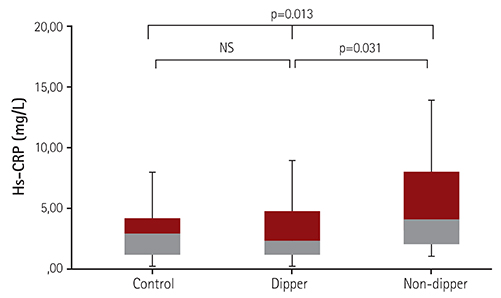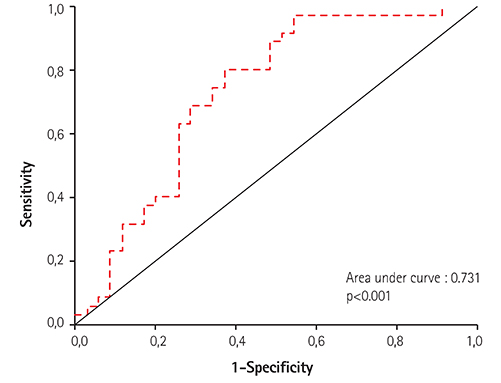Korean Circ J.
2016 Nov;46(6):827-833. 10.4070/kcj.2016.46.6.827.
Endocan and Non-Dipping Circadian Pattern in Newly Diagnosed Essential Hypertension
- Affiliations
-
- 1Department of Cardiology, Dışkapı Yıldırım Beyazıt Training and Research Hospital, Ankara, Turkey. drtolgacim@hotmail.com
- 2Department of Clinical Biochemistry, Dışkapı Yıldırım Beyazıt Training and Research Hospital, Ankara, Turkey.
- KMID: 2355459
- DOI: http://doi.org/10.4070/kcj.2016.46.6.827
Abstract
- BACKGROUND AND OBJECTIVES
Non-dipper hypertension is frequently accompanied by endothelial dysfunction and activation. Previous studies suggested that endocan may be a novel endothelial dysfunction marker. This study aims to investigate the association between circadian blood pressure (BP) pattern and plasma endocan levels together with high-sensitivity C-reactive protein (hsCRP) in patients with newly diagnosed untreated hypertension.
SUBJECTS AND METHODS
Twenty-four hour ambulatory blood pressure monitoring was recorded in 35 dipper, 35 non-dipper hypertensives and 35 healthy controls. Endocan levels were measured by enzyme-linked immunosorbent assay. Serum levels of hsCRP were also recorded.
RESULTS
Despite similar daytime and 24-hour average BP values between dippers and non-dippers, statistically significant high nocturnal BP was accompanied by a non-dipping pattern (Systolic BP: 132±9 vs. 147±11 mmHg; Distolic BP: 80±7 vs. 91±9 mmHg, respectively, p<0.001 for both). Non-dipper patients demonstrated higher endocan levels compared to dippers and normotensives (367 (193-844) pg/mL, 254 (182-512) pg/mL and 237 (141-314) pg/ml, respectively, p<0.001). HsCRP levels were significantly higher in non-dippers than the other groups (p=0.013). In a multivariate logistic regression analysis, endocan (p=0.021) and hsCRP (p=0.044) were independently associated with a non-dipping pattern.
CONCLUSION
Elevated endocan levels were found in non-dipper groups. Endocan and hsCRP were found to be independently associated with a non-dipping pattern. We suggest that elevated levels of endocan in non-dipper hypertensive patients might be associated with a longer duration of exposure to high BP. These results point to the possible future role of endocan in selection of hypertensive patients at higher risk or target organ damage.
MeSH Terms
Figure
Reference
-
1. Kannel WB. Blood pressure as a cardiovascular risk factor: prevention and treatment. JAMA. 1996; 275:1571–1576.2. Panza JA, Quyyumi AA, Brush JE Jr, Epstein SE. Abnormal endothelium-dependent vascular relaxation in patients with essential hypertension. N Engl J Med. 1990; 323:22–27.3. Verdecchia P, Schillaci G, Porcellati C. Dippers versus non-dippers. J Hypertens Suppl. 1991; 9:S42–S44.4. Verdecchia P, Schillaci G, Borgioni C, et al. Altered circadian blood pressure profile and prognosis. Blood Press Monit. 1997; 2:347–352.5. Verdecchia P, Schillaci G, Guerrieri M, et al. Circadian blood pressure changes and left ventricular hypertrophy in essential hypertension. Circulation. 1990; 81:528–536.6. Yan B, Peng L, Han D, et al. Blood pressure reverse-dipping is associated with early formation of carotid plaque in senior hypertensive patients. Medicine (Baltimore). 2015; 94:e604.7. Higashi Y, Nakagawa K, Kimura M, et al. Circadian variation of blood pressure and endothelial function in patients with essential hypertension:a comparison of dippers and non-dippers. J Am Coll Cardiol. 2002; 40:2039–2043.8. Béchard D, Meignin V, Scherpereel A, et al. Characterization of the secreted form of endothelial-cell-specific molecule 1 by specific monoclonal antibodies. J Vasc Res. 2000; 37:417–425.9. Bechard D, Scherpereel A, Hammad H, et al. Human endothelial-cell specific molecule-1 binds directly to the integrin CD11a/CD18 (LFA-1) and blocks binding to intercellular adhesion molecule-1. J Immunol. 2001; 167:3099–3106.10. Grigoriu BD, Depontieu F, Scherpereel A, et al. Endocan expression and relationship with survival in human non-small cell lung cancer. Clin Cancer Res. 2006; 12:4575–4582.11. Abid MR, Yi X, Yano K, Shih SC, Aird WC. Vascular endocan is preferentially expressed in tumor endothelium. Microvasc Res. 2006; 72:136–145.12. Balta S, Mikhailidis DP, Demirkol S, et al. Endocan--a novel inflammatory indicator in newly diagnosed patients with hypertension: a pilot study. Angiology. 2014; 65:773–777.13. Wang XS, Yang W, Luo T, Wang JM, Jing YY. Serum endocan levels are correlated with the presence and severity of coronary artery disease in patients with hypertension. Genet Test Mol Biomarkers. 2015; 19:124–127.14. Lang RM, Badano LP, Mor-Avi V, et al. Recommendations for cardiac chamber quantification by echocardiography in adults: an update from the American Society of Echocardiography and the European Association of Cardiovascular Imaging. J Am Soc Echocardiogr. 2015; 28:1–39.e14.15. Mancia G, Fagard R, Narkiewicz K, et al. 2013 ESH/ESC guidelines for the management of arterial hypertension: The Task Force for the Management of Arterial Hypertension of the European Society of Hypertension (ESH) and of the European Society of Cardiology (ESC). Eur Heart J. 2013; 34:2159–2219.16. Lassalle P, Molet S, Janin A, et al. ESM-1 is a novel human endothelial cell-specific molecule expressed in lung and regulated by cytokines. J Biol Chem. 1996; 271:20458–20464.17. Sarrazin S, Adam E, Lyon M, et al. Endocan or endothelial cell specific molecule-1 (ESM-1): A potential novel endothelial cell marker and a new target for cancer therapy. Biochim Biophys Acta. 2006; 1765:25–37.18. Mauno V, Hannu K, Esko K. Proinflammation and Hypertension: A population-based study. Mediators Inflamm. 2008; 2008:619704.19. Celık T, Balta S, Karaman M, et al. Endocan, a novel marker of endothelial dysfunction in patients with essential hypertension: Comparative effects of amlodipine and valsartan. Blood Press. 2015; 24:55–60.20. Tadzic R, Mihalj M, Vcev A, Ennen J, Tadzic A, Drenjancevic I. The effects of arterial blood pressure reduction on endocan and soluble endothelial cell adhesion molecules (CAMs) and CAMs ligands expression in hypertensive patients on Ca-channel blocker therapy. Kidney Blood Press Res. 2013; 37:103–115.21. Tosu AR, Demir S, Selcuk M, et al. Comparison of inflammatory markers in non-dipper hypertension vs. dipper hypertension and in normotensive individuals: uric acid, C-reactive protein and red blood cell distribution width readings. Postepy Kardiol Interwencyjnej. 2014; 10:98–103.22. von Känel R, Jain S, Mills PJ, et al. Relation of nocturnal blood pressure dipping to cellular adhesion, inflammation and hemostasis. J Hypertens. 2004; 22:2087–2093.23. Larochelle P. Circadian variation in blood pressure: dipper or nondipper. J Clin Hypertens (Greenwich). 2002; 4:4 Suppl 1. 3–8.24. de la Sierra A, Redon J, Banegas JR, et al. Prevalence and factors associated with circadian blood pressure patterns in hypertensive patients. Hypertension. 2009; 53:466–472.25. Lurbe E, Redon J, Kesani A, et al. Increase in nocturnal blood pressure and progression to microalbuminuria in type 1 diabetes. N Engl J Med. 2002; 347:797–805.26. Fan HQ, Li Y, Thijs L, Hansen TW, et al. Prognostic value of isolated nocturnal hypertension on ambulatory measurement in 8711 individuals from 10 populations. J Hypertens. 2010; 28:2036–2045.27. Ozdemir E, Yildirimturk O, Cengiz B, Yurdakul S, Aytekin S. Evaluation of carotid intima-media thickness and aortic elasticity in patients with nondipper hypertension. Echocardiography. 2014; 31:663–668.28. Amiya E, Watanabe M, Komuro I. The Relationship between Vascular Function and the Autonomic Nervous System. Ann Vasc Dis. 2014; 7:109–119.29. Millar-Craig MW, Bishop CN, Raftery EB. Circadian variation of blood-pressure. Lancet. 1978; 1:795–797.30. Watson RD, Hamilton CA, Reid JL, Littler WA. Changes in plasma norepinephrine, blood pressure and heart rate during physical activity in hypertensive man. Hypertension. 1979; 1:341–346.
- Full Text Links
- Actions
-
Cited
- CITED
-
- Close
- Share
- Similar articles
-
- Plasma endocan level and prognosis of immunoglobulin A nephropathy
- Evaluation of Endothelial Dysfunction in Bipolar Affective Disorders: Serum Endocan and Urotensin-II Levels
- Association among epicardial fat, heart rate recovery and circadian blood pressure variability in patients with hypertension
- Circadian Variation of Ventricular Premature Complex in Hypertension and Ischemic Heart Disease Patients
- A Reverse Dipping Pattern Predicts Cardiovascular Mortality In a Clinical Cohort




